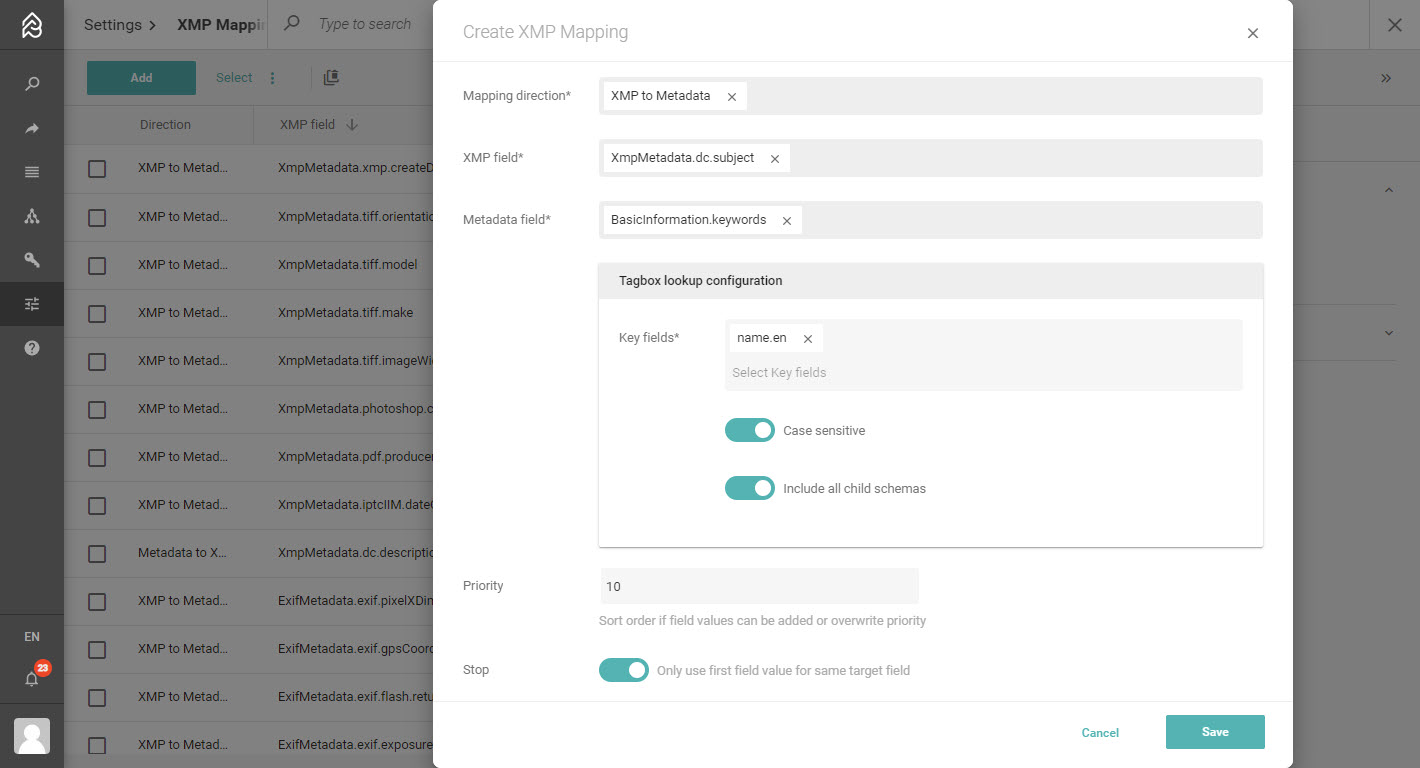XMP Mapping
XMP Mapping allows the extraction and import of XMP/EXIF data into Picturepark metadata fields and the exporting of data from Picturepark metadata fields into XMP based on field mappings. The XMP handling happens when importing files into Picturepark or exporting from Picturepark. XMP Mapping must be enabled for the required output formats via API so that the downloaded output format contains the data.
Supported File Formats: https://exiftool.org/#supported
Supported XMP: https://exiftool.org/TagNames/XMP.html
Create XMP Mapping
Prerequisites
Files with supported XMP metadata
Picturepark fields to write XMP into, mapped to a Layer
Our Goal
We have a Basic Information Layer with a text field "Title".
We want to store the title from Dublin Core into the Picturepark title field.
We want to update the Dublin Core title with updated title information from Picturepark.
Add XMP Mapping
These mappings enable admins to select mapping direction (write to Picturepark, write to File, or both), the XMP field (Dublin Core, IPTC, and others), and the corresponding metadata field in Picturepark. Priority defines in which order multiple values are written into the same field (separated by comma). The stop switch prevents that after the first value is added, additional values are written if they exist for the same field.
You must select mapping direction in order to be able to select a field.
Open Settings
Open XMP Mappings
Add a new mapping
Select the mapping direction "Both"
as we want to write to Picturepark
and we want to write back to XMP
Select the XMP Field "dc.title".
Select the Picturepark field "basicInformation.title"
Save
When you write XMP back to the file then Picturepark creates a historic version with the original XMP when a user downloads the file. This makes sure that the original XMP is always available.
Create XMP Mapping on Translated Fields
Prerequisites
Files with DC Subject keywords in English, in German.
Picturepark list items with translated text fields as names, all translated.
Our Goal
The XMP mapping should map all subject keywords from the files into the tagbox if either the German or English translation is used.
Add XMP Mapping
The German translation and the English translation count as different fields. If you want to lookup on two different fields, you'll need to configure two mappings (and you are also then able to specify a priority between them; e.g. name.en with priority 10, stop = true, and then name.de with priority 9. This will lookup in English names first, if found the lookup stops, otherwise it will check the German name.
You must select the mapping direction in order to be able to select a field.
Open Settings
Open XMP Mappings
Add a new mapping
Select the mapping direction "XMP to Metadata"
as we want to write to Picturepark
and we do not want to write back to XMP
Select the XMP Field "dc:subject".
Select the Picturepark tagbox field "basicInformation.keywords"
Select the name field in the first language: name.en
Select case insensitive
Select all child schemas
Select Priority 10
Select Stop
Save

German and English translation count as different fields. for lookup on two different fields, configure two mappings; one for name.en and another one for name.de
You cannot add both translations as keys, cause the values would be concatenated; e.g. if you add name.en “Apple” and name.de “Apfel” as key fields, you get “AppleApfel” as imported value.
Add another new mapping
Select the mapping direction "XMP to Metadata"
as we want to write to Picturepark
and we do not want to write back to XMP
Select the XMP Field "dc:subject".
Select the Picturepark tagbox field "basicInformation.keywords"
Select the name field in the second language: name.de
Select case insensitive
Select all child schemas
Select Priority 10
Save
Update XMP Mapping
Prerequisites
XMP mapping created
A layer "Basic Information" with a string field "Description"
Our Goal
Update Picturepark fields
Update XMP fields
Update mapping direction
Disable XMP mapping.
Update the XMP Mapping
Do not remove the mapping direction as this will remove your mapped fields. If you did by accident press Cancel to keep the original settings.
Open Settings
Open XMP Mappings
Filter by Schema where your mapped field is added.
Filter by mapping direction.
Click to open an existing mapping.
Remove the Picturepark field "basicInformation.title"
Add the Picturepark field "basicInformation.description.en"
Save
Delete XMP Mapping
Prerequisites
XMP mapping created
Our Goal
Remove XMP Mapping
Delete the XMP Mapping
The mapping values will be removed in a periodical task.
Open Settings
Open XMP Mappings
Filter by Schema where your mapped field is added.
Filter by mapping direction.
Select existing mapping in the list (checkbox)
Remove the mapping
Save
Use Cases
Museums rely heavily on correct metadata and rights attribution for their digital objects. For museums, it is key to map the correct metadata for the core work, as well as the works of others it includes. These are several layers of rights metadata that can easily be managed in Picturepark using Picturepark Layers and written back into the file’s XMP copyright information.
The music industry went from 100,000 physical albums released in a year to 25,000 digital songs uploaded a day to the streaming services. These songs feature one and often multiple artists, which are hard to track in the title or descriptive information. Using Picturepark Tagbox functionality all artists are added as tags and written back into the XMP creator information.
Every other company, producing digital works, has the same challenges. Images, Videos, and Audio are shared among social platforms in seconds without any consideration of copyright. This can get messy and expensive. Therefore it is important to have the correct metadata applied and written back into the file.
Limitations
You must select the mapping direction first.
Data is always written to XMP even when writeback is disabled. To enable XMP writeback for the original you must create a copy of the original using “copyFormat” and apply the XMP mappings. Picturepark will then write XMP to the file on download.
Changes to the mapping direction of an existing XMP mapping will remove the mapped fields, so you have to cancel to keep your mapping settings.
Mappings that try to map different value formats are invalid. So if you try to map a text to a number field the value is not mapped. There will be no errors.
You cannot map to a Layer with required fields. You can only map to a Layer with no required fields configured.
You cannot make a field required on a layer that has mappings.
You cannot remove File Types or Layers that have mappings.
You cannot remove a Layer from being available for File Types when the Layer has mappings.
You cannot remove a field that has mappings.
You cannot map to a field of a Layer that is not available for any file type e.g. Layers only for Virtual Types are not supported.
XMP values are written as a background task periodically. You might see the values not directly after import.
Supported data types: Strings, Translated strings (language needs to be specified), Tagboxes, Dates, Numbers, and Geopoints.
